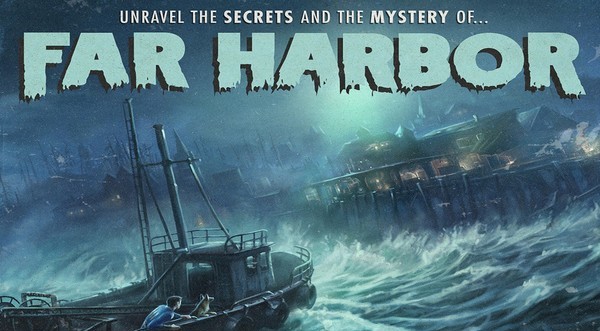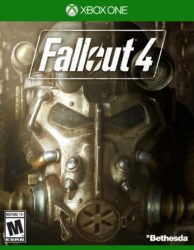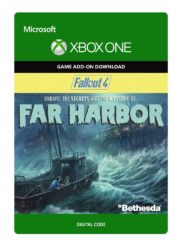Looking back at all of the video game releases of 2015, few games enjoyed the same level of commercial, and to some extent, critical success as Fallout 4. The fifth installment in the series, the massive open world role-playing game was a behemoth in terms of sells, well outpacing many games (even those that were deserving of attention) that were unlucky enough to share its coveted fall release date.
While obviously popular, that’s not to say that Fallout 4 did not suffer from a few problems. Despite the overwhelming amount of content and the sheer ambition on the part of the developers in creating a post-apocalyptic Boston filled with warring tribes and monstrous creatures, many would not disagree that Fallout 4 was free from the familiar and increasingly annoying problems that so often plague Bethesda Game Studios’ titles. Along with frame rate issues, low-resolution visuals, texture popping and occasionally wonky AI, the game’s central storyline wasn’t particularly interesting, especially when compared to just a handful of Fallout 4’s more outrageous and unique side-quests. Though stumbling in a number of ways, Bethesda has continued to release downloadable content for Fallout 4, the most recent being Far Harbor. This expansion, while large and compelling enough to bring die-hard fans back for another romp across the American wasteland, not only features the all too familiar problems that bogged down the base game, but also introduces several new frustrations as well.
Unlike Fallout 4’s previous DLC additions, Wasteland Workshop and Automatron, both of which offered little outside of new cosmetic additions to the base game, Far Harbor adds an entirely new area for players to explore and dozens of new quests to complete. The landmass of Far Harbor itself, an island off the coast of Maine, is the biggest map that Bethesda has ever created for a DLC, eclipsing even the largest expansion areas that were created for Oblivion, Fallout 3 and Skyrim.
Traveling to the island, players will discover that Far Harbor is occupied by three different factions: the Harbormen, the Church of the Children of Atom, and Acaida, a refuge for highly advanced synths (androids). Tensions have risen between the three groups because of the presence of a radiated fog that covers the island. The Harbormen, unable to live with the steadily encroaching fog, use air-purifying machines called “Fog Condensers” to create fresh air for themselves and their settlement. The Children of the Atom, who worship radiation and consider the irradiated fog a miracle, view the actions of the Harbormen as sacrilegious. Caught in between the two factions, the synths of Acadia attempt to placate both sides, hoping for a peaceful resolution to the conflict.
It’s the quarrel between the three factions that Far Harbor’s central storyline shines the most. As opposed to the Fallout 4’s main quest, which forced players to side with one of four different groups towards the game’s conclusion, Far Harbor takes a far more nuanced approach to its storytelling and relationships with factions, presenting players with more choices when attempting to solve the conflict. The main quest-line’s resolution, which can be attained through non-violent means, is strikingly more satisfying than Fallout 4’s various anti-climactic endings, and even expands upon the history and possible origins of the player-controlled Sole Survivor.
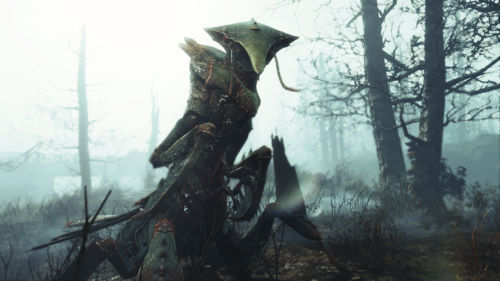
Far Harbor also introduces new and very dangerous wildlife for players to kill, and in some cases, avoid. Reminiscent of creatures one might find in the works of H.P. Lovecraft, the island of Far Harbor features such mutated monsters as Anglers, bipedal swamp fish; Gulpers, giant mutated salamanders; and Fog Crawlers, predatory shrimp creatures sporting dagger-like appendages.
Most of the new weapons and armor that is included with the DLC is maritime-themed and is reminiscent of early 20th century deep sea diving equipment. Some of the best equipable pieces that players can either find or earn are “Skipper’s Last Stand,” a powerful harpoon gun, and “Atom’s Judgment,” a radioactive super-sledgehammer.
Sadly, even with new quests to complete, creatures to kill, and equipment to collect, Far Harbor’s technical and pacing issues can’t be ignored. Though Fallout 4 often suffers from frame rate problems when players are engaged in large-scale battles, Far Harbor frequently stutters, and in some cases, freezes and crashes, when fog is on screen. Since the fog covers most of Far Harbor, these issues continue to become even more vexing as players try to complete quests and explore the entirety of the island. Additionally, since the fog is irradiated, it is almost always necessary to wear a Power Armor suit when outdoors to avoid the negative effects of radiation poisoning.
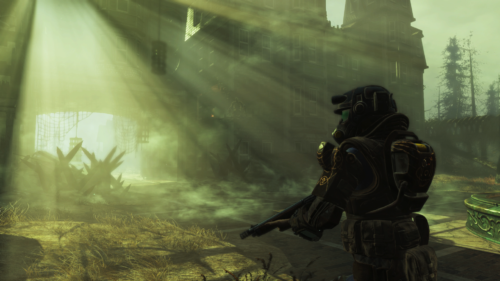
In terms of disappointing gameplay, the expansion introduces perhaps the most annoying mini-game to ever grace Bethesda’s tenure on the franchise in the form of a frustrating and lengthy virtual reality puzzle. Taking place smack-dab in the middle of the central quest, the puzzle forces players to complete a Minecraft-inspired tower defense game. Pace-breaking and time-consuming, the mini-game feels completely out-of-place in the eerie, horror-themed location that is Far Harbor.
The newest companion character/pack mule, a salty fisherman named Old Long Fellow, also has as much personality as the virtual reality puzzle, and aside from his quest reward and occasional musings on how he wants to drink himself to death, his bland voice-acting makes him a less-than adequate side-kick. For players wanting to avoid Longfellow’s company, Nick Valentine, the loveable synth companion from the main game, is worth having to tag-along with in the expansion, not only because he’s awesome and has a voice reminiscent of a 1940s private investigator, but because he has a story-arc of his own in Far Harbor.
In so many ways, Far Harbor is the best and worst of Fallout. Yes, it offers more quests and a really cool location that will assuredly take hours to thoroughly investigate and explore, but it also further cements the obvious flaws of Bethesda’s RPGs. Fallout 4 was created in the microcosm that is Bethesda Game Studios, and much like with Far Harbor, it’s becoming readily more apparent. Though Bethesda will definitely continue to produce content for Fallout 4, and in time, eventually release the next installment in the Elder Scrolls series, it would be best for them to seriously consider the litany of problems their titles are so often afflicted with, and take the necessary time to address them, in whatever way that they can, accordingly.
Arbitrary Rating: 7 out of 10 old sailor yarns
Fallout 4: Far Harbor is currently available for purchase on PS4, PC and Xbox One.
What about you reader? What did you think of Far Harbor? Do you think Bethesda Game Studios needs to address these technical issues for their future games? Let us know in the comments below!
Interested in picking up some of the titles mentioned in the article? Please use our Amazon links to do so!
